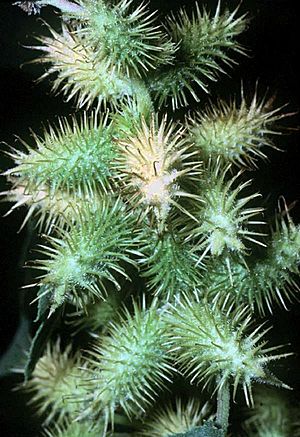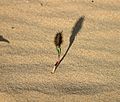Rough cocklebur facts for kids
Quick facts for kids Xanthium strumarium |
|
|---|---|
 |
|
| Xanthium strumarium | |
| Scientific classification | |
| Kingdom: | |
| (unranked): | |
| (unranked): | |
| (unranked): | |
| Order: | |
| Family: | |
| Genus: |
Xanthium
|
| Species: |
X. strumarium
|
| Binomial name | |
| Xanthium strumarium |
|
| Subspecies | |
|
|
| Synonyms | |
|
List
|
|
The Rough Cocklebur (scientific name: Xanthium strumarium) is a type of plant that grows for one year. It belongs to the Asteraceae family, which also includes sunflowers and daisies. This plant likely came from North America but can now be found in many other parts of the world. It is also known by names like clotbur and common cocklebur.
Contents
How Cocklebur Plants Reproduce
Cocklebur plants have both male and female flowers on the same plant. This is called being monoecious. The male flowers are located above the female flowers on the plant.
The female flowers are surrounded by a spiky cover called an involucre. When the plant makes fruit, these two female flowers turn into two brown or black seeds. These seeds are completely covered by the involucre, which then becomes a bur.
How Burrs Travel and Grow
The burrs are very good at traveling! If the plant grows near water, the burrs can float and spread easily in the water. But the burrs are also famous for their hooked spikes. These hooks help them stick to the fur of animals, like mammals. This is how they get carried to new places.
Once a burr falls off an animal and lands on the ground, usually one of the seeds inside will sprout. A new cocklebur plant then grows out of the burr.
Is Cocklebur Safe? Understanding Its Chemistry
The cocklebur plant has been used in traditional medicine in places like South Asia and traditional Chinese medicine. For example, in the Telugu region, it is called Marula Matangi.
However, it is very important to know that while small amounts of the mature plant might be used, the seeds and young plants (seedlings) should not be eaten in large quantities. They contain a very strong chemical called carboxyatractyloside, which is harmful. The older plant also has at least four other harmful substances.
Why You Should Be Careful with Cocklebur
- Animals have become sick or even died after eating parts of these plants.
- There was a case where a person experienced muscle spasms after taking a traditional Chinese medicine that contained cocklebur. This medicine is known as Cang Er Zi Wan.
- In 2007, during a flood in Sylhet District, Bangladesh, many people were very hungry. They ate large amounts of cocklebur plants, which they called ghagra shak, because no other food was available. Sadly, this led to 19 deaths and 76 illnesses. People experienced vomiting, confusion, and then became unconscious. This shows how important it is to be careful with plants that can be harmful.
Traditional Uses by Native Americans
The Zuni people have used a specific type of cocklebur, the canadense variety, for several purposes.
- They would chew the seeds and rub them on their bodies. This was done before a cactus ceremony to help protect them from the cactus spines.
- A special paste made from the seeds was put on wounds or used to help remove splinters.
- The Zuni people also ground the seeds and mixed them with cornmeal. They would then make these into cakes and steam them for food.
Images for kids
See also
 In Spanish: Bardana común para niños
In Spanish: Bardana común para niños





